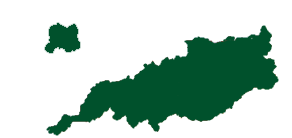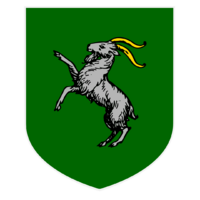Swinas
Federal Republic of Swinas Ue'republjiče Puideerače ot Sviinače | |
|---|---|
| Motto: Apače atealk pižäšetipče One can defeat all. | |
| Anthem: "Deu Tuasvelatče Žiičebodačleta" | |
 | |
| Capital | Tuasvelat |
| National Language | Sviina, Notizellio, Common |
| Ethnic groups |
|
| Demonym(s) | Sviina |
| Government | Dual-Presidential Federal Republic |
• Apa Païtnasva (First President) | Jako Tetalad |
• Kub Païtnasva (Second President) | Ljorane Riči |
| Area | |
• Total | 985,095 km2 (380,347 sq mi) |
| Population | |
• 2020 census | 42,299,153 |
| GDP (nominal) | estimate |
• Total | 448,984,350,000 |
| Currency | Sviina Dollar (SD) |
| Driving side | right |
| Calling code | +59 |
The Federal Republic of Swinas is a Dual-Presidential Federal Republic led by the First and Second President, provincial leaders, and a unicameral Senate. The Federal Government is hosted in the Capital City of Tuasvelat, and a majority of the population of Swinas speaks their native tounge, Sviina. Additionally, the island of Notizellio speaks Notizelli, and more recently, many common speakers have begun to appear in Sviinas, though Sviina continues to be the majority. Known to the native speakers of Sviinas as "Uet Republjiče Puïdeera ot Sviinasva", it covers a considerable area of 985,095 square kilometers (380,347 square miles). Banks in Sviinas use the Sviina dollar, and cars drive on the right.
History
Sviina Classical Period (500 B.C. - 136 B.C.)
The Sviina Classical Period was a period of immense cultural and artistic development in Sviinasva. During this time, Sviinasva was divided up into petty kingdoms and dependent city-states. There were three major kingdoms, them being Tuasoelat, Poišag, and Težat. Tuasoelat was located in Northern Sviinasva, Težat in South-Eastern Sviinasva, and Poišag in South-Western Sviinasva. During the Sviina Classical Period, these kingdoms frequently were in a state of war, with their dependent city-states helping the respective kingdom they were aligned to. During this time, the isle of Notizellio was completely unknown to the Sviina.
As mentioned, during this time much artistic development was ongoing in Sviinasva, mainly architecture. During this time, many great architects were emerging from all 3 areas of Sviinasva, such as Siraket. He was the man who oversaw the construction of the temple of Pekuljak, the god of Agriculture, in the Kingdom of Težat. This temple was of great significance not just to the people of that kingdom, but of all the Kingdoms, and was visited by many from the Kingdom of Tuasoelat and Poišag. This is just one of many examples of the great architectural work ongoing during this period in Sviina History.
During this time period, many wars were also occuring, as previously mentioned. In chronological order, it goes; The Supääp Wars, the Karetsa War, and the Bïubek Wars. While many more war occurred, those other wars are minor, whilst these wars were significant to the history of Classical Sviinasva. The first war mentioned was the Supääp Wars. These were a series of 2 wars which were 30 years apart from each other. The First Supääp War was fought over the city-state of Supääp. Before the war. Tuasoelat had been making negotiations with the city-state to join the Tuasoelat League. Meanwhile, Poišag had also been undergoing negotiations with this city-state. After much consideration from this city-state, however, they decidided to join the Tuasoelat League. This infuriated Poišag, so they laid siege and razed the city-state. This in turn enraged Tuasoelat, who joined the war shortly after it's actual declaration, thus beginning the Supääp Wars.
The first major battle was the battle of Edäapä, which was a pyrrhic victory for Poišag. The loss of life did lead to only one more battle being fought, before they were forced to entrench until winter was over, which
The Sviina Civil War (1921 A.D. - 1925 A.D.)
Though the official fighting had only occurred 4 years, the effects of it are still present, especially in the Sviina Countryside, where many towns have been abandoned due to the war. Until recently, a large amount of government funds had been allocated towards the Oho Pižaageegat Païtižätip, or, the Anti Socialist Authority. Though actual fighting began in 1921, the social tension could date back to the spread of socialist, agrarian ideals in Southern Sviinas, where farmers began speaking out against Sviina legislation they saw as against their way of life. Suddenly, the Sviina Socialist Party would be founded in 1909, and would go on to pass legislation which promised development of Southern Sviinas, and general agrarian reforms. By 1913, the Sviina Federal Party opposed the Sviina Socialist Party, and political tensions continued to rise. The straw that broke the camel's back, however, was in early 1920 when Socialist Officials were arrested in what was considered an illegal operation by the Socialist Party.
The Sviina Socialist Party would begin preparing for a Civil War, and the question now was not "if", but rather "when". That question would be answered in March of 1921, nearly a year after the incident, when the rural south would rise up and arrest any mayors or provincial leaders that were known to be members of the Sviina Federal Party. Many would be killed in a brutal incident known as the March Uprising. From there, things only continued to get worse, as the government in Tuasvelat would officially deploy the military. Any militaries loyal to the Sviina Socialist Party, however would disobey their commanders, and would assist the Socialists. The Sviina Government would launch offensives in key northern cities immediately, possibly preventing an early Socialist Victory. From there, the Socialists would many times threaten the capital of Tuasvelat.
Čukaanad, the First President at the time would make a public declaration in Tuasvelat mere hours after a nearby battle, promising that he would not allow the red menace to step foot into Tuasvelat. A similar speach would also be made to the Military. Inspired by this confidence, soldiers would valiantly fight against the socialists, eventually pushing them far from Tuasvelat. The socialists, having lost the upper hand, would initiate their Plan B, which was a naval invasion of Notizellio. This island just so happened to be a key naval base of the Sviina before the war, but the socialists, right before the outbreak of the war, had aligned many admirals to them. Those who remained on the side of the Federal Republic were to attempt Naval Dominance.
In mid-1923, the socialists would launch their naval attacks, destroying many ships belonging to the Federal Republic. It was brutal fighting, which saw many casualties. During this, land fighting had not stopped, either. Many battles would also occur on land, killing many. One battle would even result in the loss of a key Socialist General. Regardless, they persisted, and would eventually make landfall. Many Federalists thought that the isle would fall into Socialist Hands, but as it turns out, the invasion force had actually been worn down quite a bit during the naval fighting for many months. As a result, fierce battles would be fought as the soldiers on the island would attempt to hold off the Socialists, waiting for reinforcements to arrive. One key battle that demonstrates their complete will to fight was the battle of Lang Bridge.
The battle of Lang Bridge was a deadly battle for the socialists in Notizellio. Lang Bridge was across a river that led to a major Notizelli city. The democratic soldiers had one order from their general, "Oho apa setimetera puše!", which translated to "Not a centimeter back!" This order was received well by the soldiers, who fought valiantly for the bridge, and ultimately won the battle, eventually after many months, the socialists would be forced to flee due to a democratic blockade, though their escape would be deadly, resulting in countless deaths. By 1924, the Sviina Navy had full dominance against the Sviina Socialist Navies, and had begun pushing the socialists back on land.
By 1925, the Sviina Armies had besieged the Socialist Capital City of Pvišag. From their, fierce fighting came from the remaining Socialist Armies, as they had falsely believed that reinforcements would arrive from the South-West. Little did they know, the general who sent that letter had surrendered in battle. Eventually, the Sviina Armies would breach the socialist defenses after a weakness of supply, and the Socialist Armies would ultimately surrender in August of 1925. Many socialists would be imprisoned for life, and countless Socialist Soldiers would be executed via the Great Socialist Purge, and Sviinasva would ultimately return to a peaceful state, with the rebuilding process beginning in 1926.
Government
The Government of Swinas will now be explained in full depth. The Government of Swinas is divided into 3 echelons, the first being the Consuls, the next being the Senate, and finally the Provinces. The consuls are the easiest to explain, and will be discussed first. The requirements to become a consul are that you must be at least 30 years old, you must have been a member of the senate for 5 years, and you must be born in Swinas or your parents were born in Swinas. The two consuls share the power to veto and approve legislation, but if the Senate counters the veto with a 75% majority then it is passed regardless. The two consuls must both sign legislation before it is passed. Then there is the Senate. The Modern Senate is comprised of 100 members, but this number has changed throughout history. To be a member of the Senate you must be 20 years old. A senator has one vote each, and a simple majority of 51/100 can pass a law. If both consuls veto a law, then it can be countered by a 75/100 majority, which will override the Consul Veto and force the law to be passed. The Senate has some limitations per what laws it can pass due to the constitution, mainly that it cannot impede upon the established Bill of Laws. Laws in the Bill from the beginning of the Federal Republic cannot be easily removed, but newer ones are easier to remove.
Lastly there is the provinces. Each province has a governor who can choose to follow or not follow certain legislation passed by the Senate. In addition, the Governor acts as the speaker of the Province, as there is also a Provincial Assembly in every province which has a member count proportional to it's population. These provincial assemblies can only pass laws which involve the province they are in, however. The consuls, senate, and provinces altogether make up the Modern Government of Swinas, which has been in place for 400 years and is still stable today.

